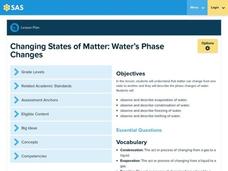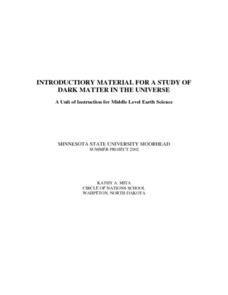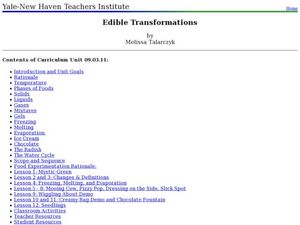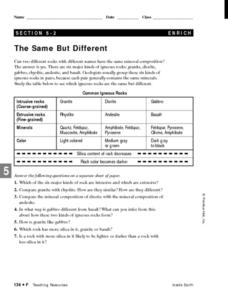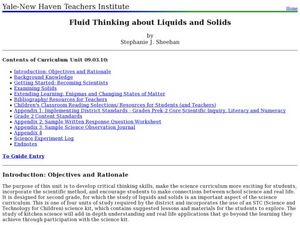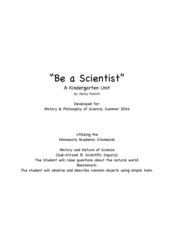Curated OER
It's The States of Matter
Students investigate the properties of solids, liquids and gases. For this states of matter lesson plan, students observe dry ice and its characteristics. They calculate the density of dry ice and observe the sublimation of the dry ice...
Pennsylvania Department of Education
Changing States of Matter: Water’s Phase Changes
Third graders observe the properties of water and in its different states. In this states of matter lesson, 3rd graders view a video, read The Magic School Bus at the Waterworks and experiment with freezing, melting and boiling...
Curated OER
Physical and Chemical Properties of Matter
Students identify the physical and chemical properties of matter. They review the types of matter. Students list the four states of matter (Solid, Liquid, Gas and Plasma). They recognize and describe the different types of matter.
Curated OER
States of Matter
Students discover states of matter. In this science lesson plan, students define matter, identify states of matter, explain properties of matter, and demonstrate the various uses of the states of matter.
Curated OER
States of Matter For Grades Kg-8
Students conduct studies of states of matter. In this science lesson plan, students observe the properties of matter and classify different substances as solids, liquids, and gases.
Curated OER
States of Matter
Student explore states of matter. In this science lesson plan, students define matter, identify the states of matter, tell about the properties of each state of matter, and demonstrate an understanding of the difference between a...
Curated OER
What's the Matter?
First graders identify solids, liquids, and gases. In this matter lesson, the teacher guides students through numerous demonstrations as they determine the properties of solids, liquids, and gases and classify things as each. As the...
Curated OER
Dark Matter In The Universe
Students investigate the concept of dark matter and how it occurs in the universe. They conduct research using a variety of resources. Students use the information by reading at least two articles about dark matter. They also generate...
Virginia Department of Education
The Law of Conservation of Matter
The Law of Conservation of Matter can be complex for young scientists to fully grasp. Use this experiment to help simplify the process as pupils perform two experiments to determine mass: one that melts a substance and the other that...
Curated OER
Dry Ice: Simply Sublime
A fascinating instructional activity on states of matter is here for your young scientists. Dry ice is used to challenge learners preconceived notions about how solids work. They discover all sorts of interesting facts about states of...
Curated OER
Edible Transformations
Learners differentiate the different phases of matter. In this chemistry lesson, students conduct several hands-on exercises to discover how matter transforms when mixed together. They identify the different stages in the water cycle.
American Chemical Society
Condensation
It's time to break the ice! If you are doing all of the lessons in the unit, children have already seen that increasing heat increases the rate of evaporation, but is the opposite true? Does decreasing temperature cause more condensation...
Curated OER
It's a Gas! Or is it?
Oceanography enthusiasts are given a series of thought experiments to consider in order to relate the solubility of gases and solids to underwater volcanoes. It is not particularly engaging to perform these thought experiments. Choose...
Curated OER
Water and Ice
Students will observe, measure and describe the phase changes of ice. In this science lesson plan, students observe ice as it changes phases. Qualaitative notations made by individual students will be shared and compared.
Curated OER
The Same, But Different
Third graders examine the phase change between solids and liquids and determine it to be a physical change. Ice is the perfect item to use to demonstrate this phase change. Pupils experiment with measuring and weighing solid ice and the...
Curated OER
Fluid Thinking About Liquids and Solids
Second graders examine the physical characteristics of the different states of matter. In this chemistry lesson, 2nd graders observe how matter changes from one phase to another. They classify substances according to its type of matter.
Curated OER
What's the Matter? Where Did it Go?
Eighth graders analyze questions posted on a large poster in the room and work in groups to record their response to the question on paper, rotating to the next question after two minutes have passed. They review the characteristics of...
Curated OER
What's Matter?
Middle schoolers explore the definition of matter. In exploring matter lesson plan students get into groups and navigate the Internet to answer questions.
Curated OER
Eight Lunar Phases, Lunar Rotation and Revolutionary Periods
Eighth graders create a slide show to show their knowledge of the eight lunar phases and lunar rotation and revolutionary periods.
Curated OER
Mixing It Up!
Third graders identify the different states of matter. In this science lesson, 3rd graders describe the different components of solutions and mixtures. They create emulsions, foams and suspensions in the lab.
Curated OER
Be a Scientist: A Kindergarten Unit
Students conduct observations using their five senses. In this science lesson, students describe different states of matter. They investigate the factors affecting mold growth.
Curated OER
Phases of Matter
Students describe the motion of solids, liquids and gases. In this chemistry lesson, students describe how temperature affect motion of the particles. They determine the physical properties of each phase.
Virginia Department of Education
States of Matter
Scientists have been studying exothermic reactions before they were cool. The lesson begins with a discussion and a demonstration of heat curves. Scholars then determine the heat of fusion of ice and the heat needed to...
Curated OER
Ice Cream
Open this instructional activity by giving a brief history of ice cream. Using liquid nitrogen to lower the temperature, preteens make their own confection. The accompanying activity sheet queries learners about freezing point, the...

